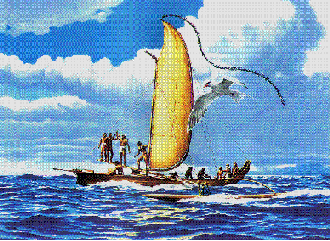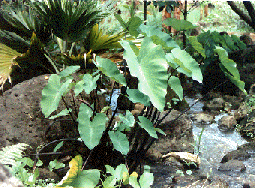 Maui Magic
Maui Magic 
 Maui Magic
Maui Magic 
 |
The Canoe Plants |
 |


Polynesians began to arrive on Maui's shores about AD800. They had journeyed from the Marquesas and Society Islands and braved rough waters in their canoes as they navigated by the stars across thousands of miles. Within the canoes were stashed precious cargo. The roots, cuttings, shoots and seeds of plants for food, cordage, medicine, containers, fabric - life's needs, both physical and spiritual, all traveled here. An active relationship qnd partnership existed between humans and plants. Cultivation occurred through selection and preservation. Just imagine a culture without clay or iron, whose people trusted enough in the intrinsic nature of 24 plants to be life sustaining. Below are a few of these important plants that the Polynesians brought over on their canoes.
 |
Kalo is believed to have the greatest life force of all foods. According to legend kalo grew from the firs-born son of Wakea (sky father) and Papa (earth mother). Haloa-naka, as the son was named, was stillborn and buried. Out of his body grew the kalo plant. As a ritual the eating of kalo as poi(pounded kalo) around the poi bowl at the center of the diners maintained social protocol, which brings people together in the spirit of `ohana (family). As medicinal uses kalo is used to settle the stomach. Mixed with ripe noni fruit, it can be applied topically for boils. It can be mixed with arrowroot starch and taken for diarrhea. Undiluted poi is sometimes used as a poulitce on infected sores. |
| Awa grows wild now and is also cultivated throughout the Pacific Islands, where it is called Kava or Kava Kava. It is valued as an intoxicating drink and as a medicine. Awa is also used as a sacred plant for prayer. As a medicine, the leaves, stems, bark and roots are used for: general debility, weary muscles, chills, colds, headaches, lung and other respiratory diseases such as asthma. The leaf buds are given to the child after being chewed by the motherTo make feverish or restless young children go to sleep. In the old days, it is said that the chiefs and priests were the principal users of awa. Special cups, made from coconut shell cut lengthwise are often reserved for this brew, and for the social ceremony of awa drinking. When awa cups are filled, a prayer of gratitude is offered. Awa is usually gulped rather than sipped, with some of the liquid being left in the container and poured upon the earth, with thanksgiving. |
|
|
Ki is considered sacred to the Hawaii God Lono and to the Goddess of the hula, Laka. It is also an emblem of high rank and divine power. The Hawaii feather kahili is said to be derived from this plant. The leaves are worn or carried as protection to ward off evil spirits. Ki leaves are still used today in religious ceremonies conducted by Hawaii's clergy, especially at opening ceremonies to bless new buildings and projects. This versatile plant has many medicinal uses. For fever, an unclothed prone person is covered from the neck down with ki leaves. After the patient sweats and fever is broken, the leaves are removed. Cool green ki leaves, held and wrapped around the forehead and temples, can be helpful in relieving headache. Hot stones are wrapped in ki leaves and used to soothe sor back muscles. A drink from boiled ti leaves is used to aid nerve and muscle relaxation. Steam from boiled shoots and leaves makes an effective decongestant. The pleasantly fragrant flowers are also used for asthma. |
